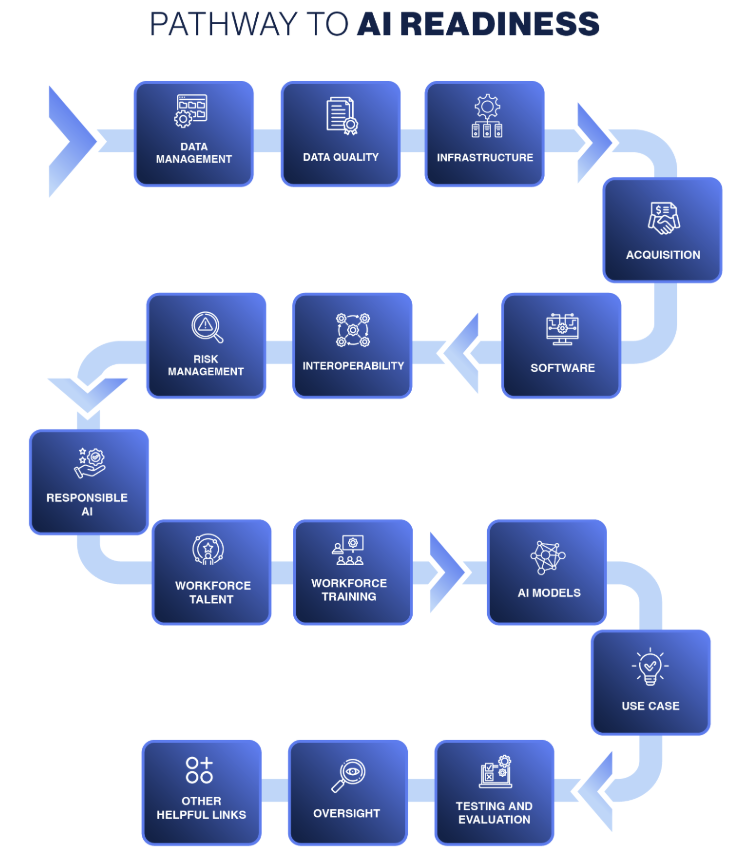AI Research
Frontier AI companies land Department of Defense deals

The US Department of Defense has awarded contracts to Anthropic, Google, OpenAI and xAI with a ceiling of $200 million to each vendor to leverage AI models for national security.
The award, announced by the DoD’s Chief Digital and Artificial Intelligence Office (CDAO), amounts to a major win for frontier AI companies looking to advance in the public sector.
Google Cloud has the most built-out public sector business of the four companies awarded contracts by the DoD.
According to CDAO, the awards to the AI companies are aimed at developing “agentic AI workflows across a variety of mission areas.”
Chief Digital and AI Officer Dr. Doug Matty said in a release that the awards are part of a strategy to implement commercial AI tools first. “Leveraging commercially available solutions into an integrated capabilities approach will accelerate the use of advanced AI as part of our joint mission essential tasks in our warfighting domain as well as intelligence, business, and enterprise information systems,” said Matty.
In a Google Cloud post, the company said the DoD can deploy using its Contiguous United States (CONUS) infrastructure for AI. This infrastructure leverages Google Cloud tools like TPUs, Agentspace and broader offerings in a separate Google Public Sector cloud.
Anthropic noted that it is building out its public sector efforts and gaining traction by leveraging Claude at the Lawrence Livermore National Laboratory and in US defense workflows with Palantir. Anthropic also has a government version of Claude called Claude Gov for national security customers built on top of AWS infrastructure.
For its part, OpenAI recently launched its government initiatives and has had a tailored version of ChatGPT for US government agencies since January. OpenAI for Government promises expertise and customer models for the Defense Department. xAI launched Grok For Government alongside the DoD contract.
Here’s a look at the DoD’s AI readiness framework.
AI Research
Smart Bidding Strategies with Artificial Intelligence

In construction, an accurate bid can mean the difference between a profitable year or continuous delays and costly overruns. Many contractors continue to rely on spreadsheets, fragmented data, or gut instinct to prepare bids. This leaves too much room for errors. According to Contimod, nine out of ten construction projects exceed their budgets, with average cost overruns of 28 percent, a clear sign that stronger estimation and risk analysis are needed to project margins and deliver successful projects.
At the same time, construction leaders face unprecedented pressure from rising material costs, labor shortages, and growing global supply chain disruptions. To remain competitive, firms are exploring different predictive artificial intelligence to analyze historical bid data, identify hidden risks, and forecast win rates. AI has the potential to help construction organizations not just secure more contracts, but also improve accuracy, profitability, and efficiency internally and across the entire project lifecycle.
Taking Our Process Further
At Western Specialty Contractors, we had a sound process in place, developed over decades of experience, but we recognized the opportunity to take this further with AI. By analyzing years of our own bid history, we found a practical way to bid smarter, reduce risk, and protect our people and projects.
The challenge lies in the complexity. Bidding in construction is complicated by inflated costs, shifting labor availability, unpredictable site conditions, and unique client requirements. Western Specialty Contractors needed a more reliable way to forecast which projects to pursue and how to price them. We’re experts in construction but not in AI. So, we partnered with AI specialists and worked closely to make sure they understood how our projects, field teams, and data work in the real world.
By analyzing years of our own bid history with a custom machine learning model, we achieved over 70 percent accuracy in win-loss forecasting. That meant we could prioritize high-probability opportunities and allocate resources more effectively. It’s a practical example of how AI delivers value in the field.
However, we also saw why firms still struggle to get there. Research from Bluebeam shows that while 74 percent of AEC firms use AI applications, 72 percent still rely on paper-based processes for critical stages like estimating and approvals. Without consistent historical data and connected workflows, AI’s potential stays out of reach.
More accurate bidding impacts far more than just winning work. When our estimates align closely with actual costs and timelines, we anticipate seeing fewer change orders, less rework, and tighter schedules. The connection between smart estimating and predictable project delivery is clear on our job sites every day.
Beyond our organization, we also know this idea goes beyond our own work. As highlighted at New York Build (March 2025), contractors generate massive volumes of site data, but too often it is disorganized or siloed. By connecting and sharing that data in ways that inform decisions, they can feed valuable insights back into estimating. Closing the loop between what happens on-site and what gets priced up front helps us continuously refine bids and protect margins.
Potential Applications & Advice
With the early success we’re seeing in our first foray into artificial intelligence, Western is closely evaluating other potential applications for this technology across the organization. We see AI as a supplemental tool that augments rather than replaces our estimators’ expertise. The real value comes from using AI to enhance our win-loss forecasting, which allows us to focus our resources on the most promising opportunities. That frees up our estimators to focus on what they do best: analyzing risk, shaping pricing strategies, and building trusted relationships with clients.
That said, we’ve also learned that tech alone isn’t enough. Clean, consistent historical data is critical. Without it, even the smartest AI tools won’t deliver results. Just as important is embedding AI insights directly into our day-to-day workflows. If it’s too complicated or separate from how our teams work, they won’t use it.
As we continue to develop our AI capabilities, we’re focused on leveraging a feedback loop between our bidding and project execution to continuously improve our predictive accuracy.
For those just starting out, here’s our advice:
- Partnership is essential. No single department or contractor holds all the answers for AI transformation. Our IT and finance teams needed to develop the AI bidding tool through extremely close internal collaboration. Plus, we also needed to build a trusting collaboration with our consulting partners. This ensured that everyone who held pieces of the AI transformation puzzle held a seat at the table and contributed to its success.
- Focus on the business problem, not the tech. Don’t chase AI for the sake of it. Stay clear on the real problems you’re trying to solve, whether that’s improving win rates, reducing rework, or protecting your margins. That’s what makes technology worth the investment.
- Don’t wait, start small and build iteratively. Begin with a focused pilot project like win-loss prediction before expanding. This allows you to prove value, refine your data processes, and build internal confidence in AI capabilities.
- Prioritize data quality. Conduct a comprehensive audit of historical bid and project performance data to find gaps and ensure consistency.
- Integrate AI into daily workflows. Implement AI insights within the tools and platforms estimators already use, minimizing friction and maximizing adoption.
- Invest in change management. The technology is only as good as its adoption. Ensure your teams understand how AI enhances rather than threatens their expertise and integrate these new tools seamlessly into existing workflows like your CRM system.
Taking a practical, integrated approach to AI-powered estimating unlocked benefits that go far beyond just winning more work for our teams. More reliable bids help us spend less time chasing low-probability projects, use our resources wisely, and protect our margins when market conditions shift. Accurate estimates also help us deliver jobs on schedule and within budget, which strengthens trust with our clients and builds our reputation across the industry. In construction, even small improvements in margin can make a difference. For us, AI has become vital to stay competitive, agile, and resilient.
Importantly, other industries have shown the same lesson. Companies that use data-driven tools to stay efficient tend to outperform those that stick to old habits. As more people in our industry deploy practical AI tools, we believe they’ll build smarter, faster, and with more confidence in every bid they submit.
AI Research
Are We Offloading Critical Thinking to Chatbots?
AI Research
Artificial Intelligence Cheating | Nation

We recognize you are attempting to access this website from a country belonging to the European Economic Area (EEA) including the EU which
enforces the General Data Protection Regulation (GDPR) and therefore access cannot be granted at this time.
For any issues, call 435-752-2121.
-

 Business2 weeks ago
Business2 weeks agoThe Guardian view on Trump and the Fed: independence is no substitute for accountability | Editorial
-
Tools & Platforms1 month ago
Building Trust in Military AI Starts with Opening the Black Box – War on the Rocks
-

 Ethics & Policy2 months ago
Ethics & Policy2 months agoSDAIA Supports Saudi Arabia’s Leadership in Shaping Global AI Ethics, Policy, and Research – وكالة الأنباء السعودية
-

 Events & Conferences4 months ago
Events & Conferences4 months agoJourney to 1000 models: Scaling Instagram’s recommendation system
-

 Jobs & Careers2 months ago
Jobs & Careers2 months agoMumbai-based Perplexity Alternative Has 60k+ Users Without Funding
-

 Podcasts & Talks2 months ago
Podcasts & Talks2 months agoHappy 4th of July! 🎆 Made with Veo 3 in Gemini
-

 Education2 months ago
Education2 months agoMacron says UK and France have duty to tackle illegal migration ‘with humanity, solidarity and firmness’ – UK politics live | Politics
-

 Education2 months ago
Education2 months agoVEX Robotics launches AI-powered classroom robotics system
-

 Funding & Business2 months ago
Funding & Business2 months agoKayak and Expedia race to build AI travel agents that turn social posts into itineraries
-

 Podcasts & Talks2 months ago
Podcasts & Talks2 months agoOpenAI 🤝 @teamganassi



